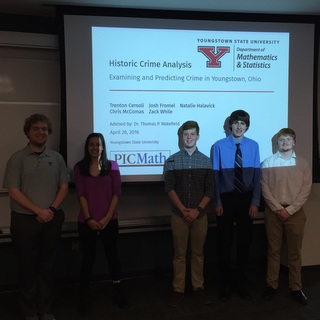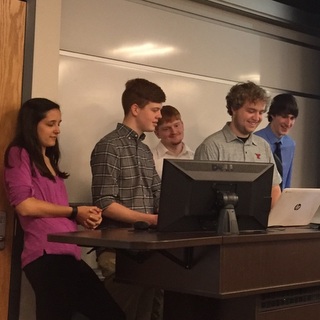Monday May 9, 2016
During the Spring 2016 semester, YSU Mathematics students, under the direction of Dr. Thomas Wakefield, analyzed historic crime and vacancy data in order to develop predictive models that show the future spread of crime and vacancy across the city.
The goal of the project was to identify specific areas of the city in need of intervention in order to prevent future crime and vacancy.
The crime analysis project examined 20 years of police reports in order to identify demographic and socioeconomic factors that correlated to neighborhood crime. Recent census data was then used to predict changes in these associated factors, allowing the student researchers to predict which neighborhoods are likely to witness an increase in crime. Results showed a projected crime decrease on the north side, increase on the south and west sides, and little change on the east side. The students found a correlation between crime and vacant properties and they theorized that by removing the number of vacant properties by 10%, a measurable decrease in crime would also be experienced in that neighborhood.
Students also examined changes in crime resulting from the impact of neighborhood cleanups, such as boarding up unsecure houses. Experimental and control groups were used to test the effect of interventions, but because the cleanups had happened relatively recently, the results were inconclusive due to the short time frames that were analyzed. The students recommended continuing to monitor the effects of neighborhood interventions on crime.
The vacancy analysis examined 10 years of parcel level data to discover factors that lead to a house becoming vacant. A 2015 vacancy survey was compared to data from the Mahoning County Auditor from 2005, as well as water shut-off data from the City of Youngstown and a housing market analysis completed by YNDC. Students found that the greatest contributing factor to whether or not a property would go vacant was the housing market where it was located. Homes in weak-market neighborhoods were several times more likely to go vacant than properties in stable market areas. Other factors found to be somewhat predictive of vacancy were tax delinquency and incidences of water shut-off. Once factors that contribute to vacancy were established, Auditor's data from 2015 was used to predict which houses might become vacant by 2025. Using their model, the students found that as many as 6,190 houses in Youngstown that are currently occupied could be vacant by 2025. Out of the 6,190 predicted vacancies, 5,034, or more than 80%, were located in weak market neighborhoods.




